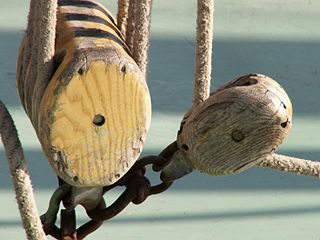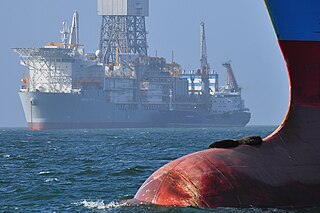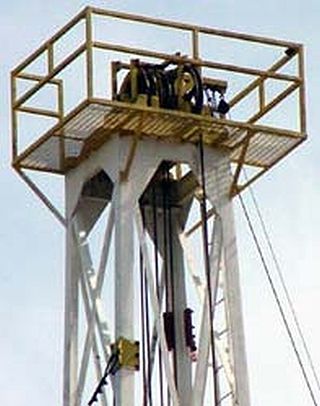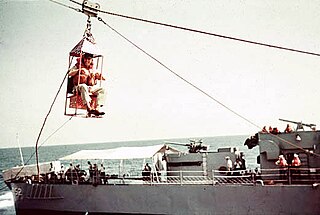
A pulley is a wheel on an axle or shaft that is designed to support movement and change of direction of a taut cable or belt, or transfer of power between the shaft and cable or belt. In the case of a pulley supported by a frame or shell that does not transfer power to a shaft, but is used to guide the cable or exert a force, the supporting shell is called a block, and the pulley may be called a sheave or pulley wheel.

An oil platform is a large structure with facilities to extract and process petroleum and natural gas that lie in rock formations beneath the seabed. Many oil platforms will also have facilities to accommodate the workers, although it is also common to have a separate accommodation platform bridge linked to the production platform. Most commonly, oil platforms engage in activities on the continental shelf, though they can also be used in lakes, inshore waters, and inland seas. Depending on the circumstances, the platform may be fixed to the ocean floor, consist of an artificial island, or float. In some arrangements the main facility may have storage facilities for the processed oil. Remote subsea wells may also be connected to a platform by flow lines and by umbilical connections. These sub-sea facilities may include of one or more subsea wells or manifold centres for multiple wells.

A block and tackle or only tackle is a system of two or more pulleys with a rope or cable threaded between them, usually used to lift heavy loads.

Running rigging is the rigging of a sailing vessel that is used for raising, lowering, shaping and controlling the sails on a sailing vessel—as opposed to the standing rigging, which supports the mast and bowsprit. Running rigging varies between vessels that are rigged fore and aft and those that are square-rigged.

A guy-wire, guy-line, guy-rope, down guy, or stay, also called simply a guy, is a tensioned cable designed to add stability to a free-standing structure. They are used commonly for ship masts, radio masts, wind turbines, utility poles, and tents. A thin vertical mast supported by guy wires is called a guyed mast. Structures that support antennas are frequently of a lattice construction and are called "towers". One end of the guy is attached to the structure, and the other is anchored to the ground at some distance from the mast or tower base. The tension in the diagonal guy-wire, combined with the compression and buckling strength of the structure, allows the structure to withstand lateral loads such as wind or the weight of cantilevered structures. They are installed radially, usually at equal angles about the structure, in trios and quads. As the tower leans a bit due to the wind force, the increased guy tension is resolved into a compression force in the tower or mast and a lateral force that resists the wind load. For example, antenna masts are often held up by three guy-wires at 120° angles. Structures with predictable lateral loads, such as electrical utility poles, may require only a single guy-wire to offset the lateral pull of the electrical wires, at a spot where the wires change direction.

A derrick is a lifting device composed at minimum of one guyed mast, as in a gin pole, which may be articulated over a load by adjusting its guys. Most derricks have at least two components, either a guyed mast or self-supporting tower, and a boom hinged at its base to provide articulation, as in a stiffleg derrick. The most basic type of derrick is controlled by three or four lines connected to the top of the mast, which allow it both to move laterally and cant up and down. To lift a load, a separate line runs up and over the mast with a hook on its free end, as with a crane.

Byford Dolphin was a semi-submersible, column-stabilised drilling rig operated by Dolphin Drilling, a Fred Olsen Energy subsidiary. It drilled seasonally for various companies in the United Kingdom, Danish, and Norwegian sectors of the North Sea. It was registered in Hamilton, Bermuda.

A fly system, or theatrical rigging system, is a system of ropes, blocks (pulleys), counterweights and related devices within a theater that enables a stage crew to fly (hoist) quickly, quietly and safely components such as curtains, lights, scenery, stage effects and, sometimes, people. Systems are typically designed to fly components between clear view of the audience and out of view, into the large opening, known as the fly loft, above the stage.

A deadeye is an item used in the standing and running rigging of traditional sailing ships. It is a smallish round thick wooden disc with one or more holes through it, perpendicular to the plane of the disc. Single and triple-hole deadeyes are most commonly seen. The three-holed blocks were called deadeyes because the position of the three holes resemble the eye and nose sockets of a sheep's skull.

Valaris Limited is an offshore drilling contractor headquartered in Houston, Texas, and incorporated in the UK. It is the largest offshore drilling and well drilling company in the world, and owns 56 rigs, including 40 offshore jackup rigs, 11 drillships, and 5 semi-submersible platform drilling rigs.
A drill string compensator decreases the influence of the heave of a drilling vessel on the drill bit. Drill string compensators are also known under the more general name: heave compensator. Drill string compensators are used onboard drill ships and semi-submersible drill rigs. There are two major types of drill string compensators:
A marine riser tensioner is a device used on an offshore drilling vessel which provides a near constant upward force on the drilling riser independent of the movement of the floating drill vessel.

Snubbing is a type of heavy well intervention performed on oil and gas wells. It involves running the BHA on a pipe string using a hydraulic workover rig. Unlike wireline or coiled tubing, the pipe is not spooled off a drum but made up and broken up while running in and pulling out, much like conventional drill pipe. Due to the large rigup, it is only used for the most demanding of operations when lighter intervention techniques do not offer the strength and durability. The first snubbing unit was primarily designed to work in well control situations to "snub" drill pipe and or casing into, or out of, a well bore when conventional well killing methods could not be used. Unlike conventional drilling and completions operations, snubbing can be performed with the well still under pressure. When done so, it is called hydraulic workover. It can also be performed without having to remove the Christmas tree from the wellhead.

A Lyle gun was a line thrower powered by a short-barrelled cannon. It was invented by Captain David A. Lyle, US Army, a graduate of West Point and the Massachusetts Institute of Technology and were used from the late 19th century to 1952, when they were replaced by rockets for throwing lines.

In a drilling rig, the drill line is a multi-thread, twisted wire rope that is threaded or reeved through in typically 6 to 12 parts between the traveling block and crown block to facilitate the lowering and lifting of the drill string into and out of the wellbore.

A crown block is the stationary section of a block and tackle that contains a set of pulleys or sheaves through which the drill line is threaded or reeved and is opposite and above the traveling block.
A drawworks is the primary hoisting machinery component of a rotary drilling rig. Its main function is to provide a means of raising and lowering the traveling block. The wire-rope drill line winds on the drawworks drum and over the crown block to the traveling block, allowing the drill string to be moved up and down as the drum turns. The segment of drill line from the drawworks to the crown block is called the "fast line". The drill line then enters the first sheave of the crown block and makes typically 6 to 12 passes between the crown block and traveling block pulleys for mechanical advantage. The line then exits the last sheave on the crown block and is fastened to a derrick leg on the other side of the rig floor. This section of drill line is called the "dead line."

A jackstay is a cable or bar between two points to support and guide a load between those points, or as an anchor to attach something to be constrained along that line. The term is mostly used in a marine context and originated on sailing ships. Note the use of "stay" implies load bearing working rigging. In diving it is also a line to guide the movements of a diver between the endpoints.
This glossary of nautical terms is an alphabetical listing of terms and expressions connected with ships, shipping, seamanship and navigation on water. Some remain current, while many date from the 17th to 19th centuries. The word nautical derives from the Latin nauticus, from Greek nautikos, from nautēs: "sailor", from naus: "ship".














